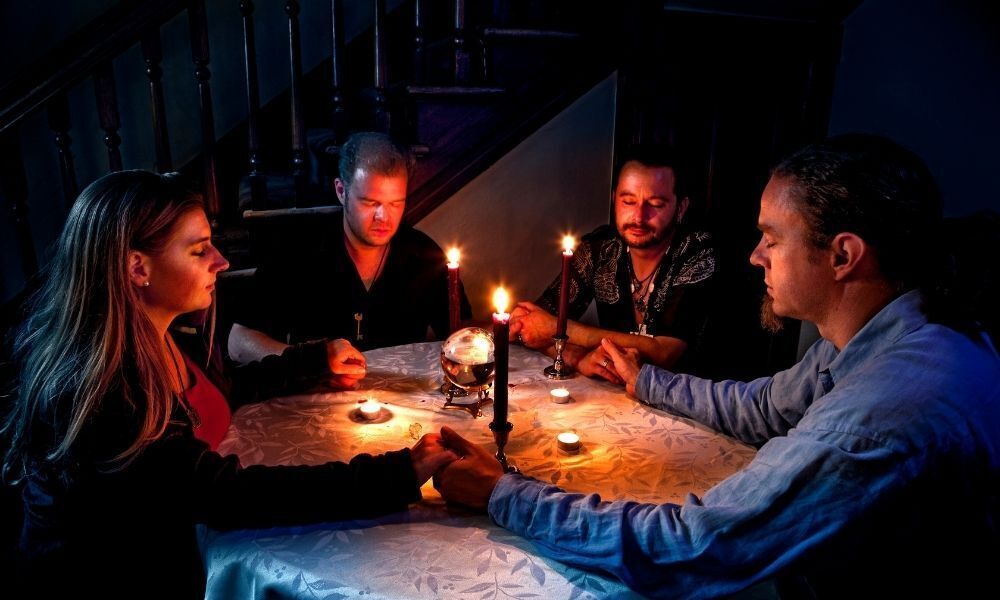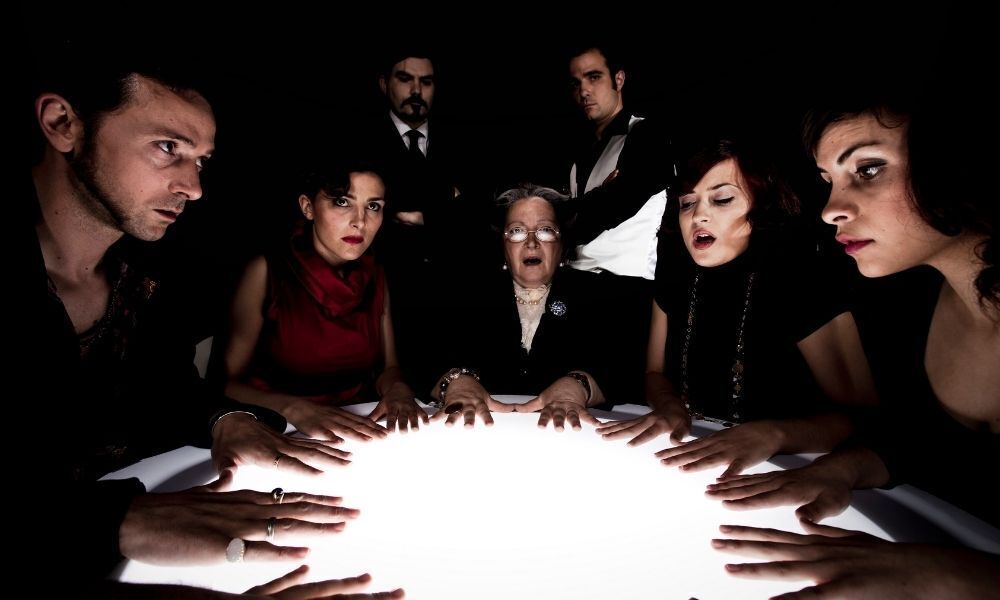Table of contents
What is white table?

The table is the most important object of the session destined to spiritual consultations, through guides, entities or spirits. What many don't know is that the white table is based on the history of Jesus Christ.
The mediums stay around the table to perform these consultations, and in it can be placed offerings to the guides. The white color has meaning based on healing and purity, symbolizes new paths.
The white table works with the present energies: water, air, fire and earth. For this reason the messages are linked to the guides who act in it, and still, there is the presence of numerology and chromotherapy that occur during the sessions. Learn more about the concept of white table and its relationship with spiritism, below.
White table concepts

The white table has this nomenclature due to the use of chromotherapy in the sessions, the relationship consists of the white color representing the purity and integrity of the world.
It was formerly known as "spiritual telegraphy," "turntable," and "talking table." See below for more on the white table.
Controversial origin in the "revolving tables
Initially, what will be explained could occur with any object, but being the table the piece of furniture that was and still is the most used for the séances, the name "turntables" prevailed.
The turntable effect is when the turntable starts to rotate suffering interference from the spirit world after the guides or mediums place their hands on it. The number of participants does not change anything, since a single medium can cause the effect alone.
Its origin occurred in the 19th century and stirred the elegant salons, as it aroused the curiosity of those who saw it moving, it even aroused the interest of Allan Kardec, an important figure for spiritism.
Energies of the white table
The white table works with the energy and vibration of the four elements: water, air, earth and fire. For this reason the messages that the spirit guides receive from the spirits are connected to these energies, so that they can be transmitted to their recipient.
And not only in the four elements the white table is based to perform their sessions, it is very common to see the use of energies released by numerology, which is the hidden meaning of numbers and also in chromotherapy which is widely used for therapeutic purposes. The color of the white table, inclusive, refers to the innocence, purity and integrity of the world.
White table guides
The guides of the white table have the important function and performance of healing. They are important entities for the doctrine in question and that have for responsibility the spiritual evolution of those who seek them and who need this intermediary.
They must help, protect and advise and because they have the most diverse gifts, they have different names according to each religion, from helpers and mentors to masters.
They position themselves around the table during the sessions and from this moment on the consultations and communications with the spiritual world take place, together with the elements they use to make the session actually happen.
How the white table works
Besides being ruled by the elements water, air, earth and fire, by numerology, astrology and chromotherapy, which work as important elements of energy and vibration, the white table also works with the action of images, candles, crystals and incense.
The sessions take place through the mediums who position themselves around the table and there start the consultation and the mediumistic communication, that is, there is the interconnection between the physical and the spiritual world. It is also on the white table that the offerings take place when made. That is, the table is literally the center and main object of the sessions.
Kardecist Table
In the Kardecist table the spirits manifest themselves through thoughts, that is, the mediums responsible for the channeling must pass on the spirits' message with their own words.
The Kardecist medium elevates his feelings in a way that after fulfilling his tasks, the spirits have as duty to accomplish other unavoidable obligations. If warnings or coercions occur during the mediumship, it will reduce the passivity and awaken animism present in Kardecism, that is, there is more and more the junction of the spiritual world with the physical one.
White table Umbanda
The white table Umbanda is an essentially religious practice and very old. It is the result of what was known as table mediumship, which already had in its sessions and tables the manifestations, which was also known as "spiritual telegraphy", "turntable" and "talking table".
The table Umbanda occurs in a freer way and is not bound to codifications, because it adopts teachings and is also based on other segments of religions.
White table and spiritism

There is a conflicting relationship between the white table and spiritism, since both are often confused due to some similarities between them, as the communication of mediums with spirits and the belief in reincarnation. But there are also the most diverse differences between them, check below.
Separate practices
The practice of Umbanda, in this case, specifically the white table practice, is a somewhat more liberal and modern practice, so that the mediums and guides do not have a mold or pattern to be followed, they do not have rules and instructions of facts already pre-established.
It is as if they let the sessions flow and flow, and the opposite should only be considered if proven in this way. However, the practice of spiritism follows exactly the opposite, being already known what course and actions should be taken, even though both believe in reincarnation and communication with spirits.
Different teaching methods
The white table and spiritism follow different teaching methods, the white table Umbanda follows a freer line and adopts teachings from other religions, through the guidance of their guides. It is a more modern and decoded methodology, in order to adopt everything that results from the session, provided that afterwards there is not something establishing the contrary.
Spiritism, however, does not open the possibility to embrace teachings and concepts outside the rules that are established in it. It is a teaching method, in general, more closed than the white table umbanda.
Different Origins
Spiritism emerged in 1857 and besides being a very old philosophical doctrine, it has a large number of adherents to the present day. The founder of the spiritist doctrine was Allan Kardec. However, the white table is of free origin and remains so today, without many standards and labels to be followed.
It is a religious doctrine developed from modern spiritualism and from the practice of its mediums in the séances. In fact, the origin of the white table took place long before Allan Kardec, since he had his attention attracted by knowing the fact of the manifestations of spirits in the séances.
Differences between white table and spiritism

When one speaks of a white table and tries to make a comparison, it is immediately noticeable the presence of numerous differences.
With differences, it can be said not so much in the matter of belief, but in the means and rules established for both to occur. See some of them below.
Thought and mediumship
As far as the white table is concerned, what occurs in practice is fully accepted by its guides. That is, everything that is revealed in the sessions is taken as truth until there is proof to the contrary in practice.
In this way, there is no standard to be followed, since it will depend on the session, its guides and elements present.
However, the difference for spiritism happens in the same moment in which this religion is adept of its rules and codifications, in a way that does not allow distancing or moving away from those previously established.
Elements
Umbanda, representing in this case the white table, believes in the energy and power emanating from the four natural elements: water, air, earth and fire. It is even through these that the messages are linked to the guides present in the sessions, so they work openly with the four elements mentioned.
However, it does not occur in the same way in spiritism, since there is no belief or use of these elements in question, leaving the white table in charge of using and receiving the energy of such elements.
Numbers and colors
The white table has a strong incidence of numerology and chromotherapy, that is, in the same way they work with the elements, they also have openly the energy of numbers and colors. The numerology consists in the observation of the occult meanings of the numbers, unchained since ancient people and still used in the sessions.
However, Spiritism has neither the basis nor the incidence of numerology or even chromotherapy, being proven the difference between the white table and Spiritism in this regard.
Offerings
For the white table, there may or may not be the offerings, there is a possibility that they are made in the sessions, however the hypothesis should not be discarded, in fact, sometimes it is encouraged. What does not occur in spiritism.
In spiritism there is no presence of offerings, nor the possibility of them being made, since their beliefs and their basis do not include the making of offerings of any kind, as happens in Umbanda, thus ruling out the custom of practicing any offering and bringing here the point of difference between the two.
Influence of the stars
As far as spiritism is concerned, there are rules and customs to be followed so that even what goes beyond the standards is generally not accepted and the same happens with the influence of the stars, since there is no regulation and belief about astrology.
Unlike spiritism, the white table is based on and influenced by the energy and vibrations of the stars, so as to characterize astrology and its applications in sessions practiced by the guides, as one of their customs, as well as the natural elements.
Pictures, candles, crystals and incense
The white table has a strong influence of images and their meanings, but not only these. The vibrations produced by the candles, the powers emanated from the crystals, the harmonic air of the environment where the incense is lit, stones, sacred objects, all have great meaning for the practitioners and guides of the sessions.
However, this is not the case in spiritism. Crystals and incense are not used as the basis of the spiritist religion, because there is not the custom and pattern of using them as in the white table.
Is the white table a religion?

The white table is a practice of spiritualist mediums based on the teachings of Jesus Christ and occurs from the coordinates of one or more guides, present in the sessions. Although it is present in some religious cults, it should be noted that the practice of the white table is totally independent and, in most cases, is not linked to any religion.
It is common for many to think directly of the connection with spiritism, because they have some similar aspects, but in fact there is the predominance of several differences. In this way, one cannot designate the White Table as a religion. It makes more sense the conception that this is an essentially religious doctrine.

